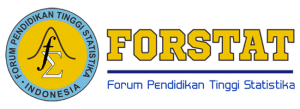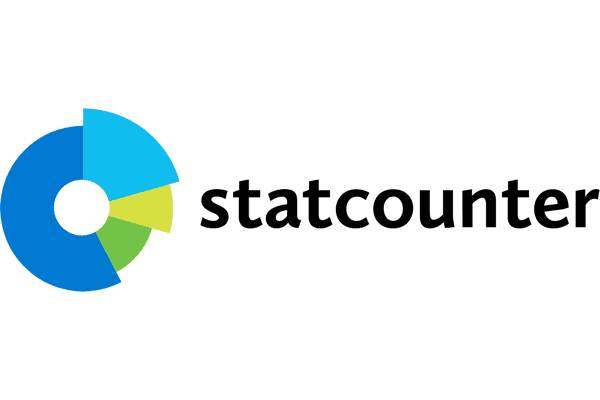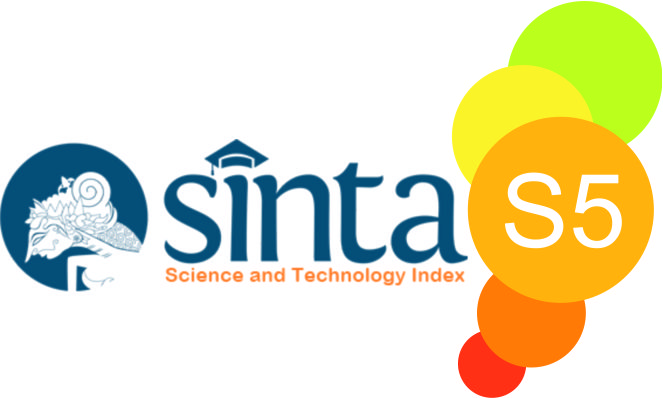Pemodelan Spasial Bayesian dalam Menentukan Faktor yang Mempengaruhi Kejadian Stunting di Provinsi Sulawesi Selatan
(1) Jurusan Statistika Fakultas Matematika dan Ilmu Pengetahuan Alam
(2) [Scopus Id: 57200984433], Departement of Mathematics, Universitas Negeri Makassar, Indonesia
(*) Corresponding Author
DOI: https://doi.org/10.35580/jmathcos.v5i1.33499
Abstract
Indonesia merupakan negara dengan prevalensi balita stunting yang tinggi. Salah satu provinsi di Indonesia yang memiliki kasus stunting yang cukup tinggi adalah Provinsi Sulawesi Selatan. Penelitian mengenai kasus stunting dan faktor penyebabnya telah dilakukan. Namun, penelitian tersebut belum mengimplementasikan model Bayesian spasial Conditional Autoregressive (CAR). Penelitian ini bertujuan untuk mengetahui faktor yang mempengaruhi kejadian stunting di Provinsi Sulawesi Selatan dengan mengimplementasikan berbagai model Bayesian spasial CAR Leroux tanpa kovariat dan dengan memasukkan kovariat dalam model. Hasil penelitian menunjukkan bahwa model terbaik dalam memodelkan kasus stunting di Provinsi Sulawesi Selatan tahun 2020 adalah model Bayesian spasial CAR Leroux dengan hyperprior Inverse-Gamma IG(0,5;0,0005) dengan memasukkan kovariat persentase kemiskinan dan persentase balita 0-59 bulan gizi kurang. Persentase kemiskinan dan persentase balita 0-59 bulan gizi kurang berpengaruh positif terhadap kejadian stunting. Semakin tinggi persentase kemiskinan dan persentase balita 0-59 bulan dengan gizi kurang di suatu wilayah, semakin tinggi risiko stunting di wilayah tersebut. 50% kabupaten/kota di Provinsi Sulawesi Selatan berada dalam kategori risiko tinggi stunting. Kota Parepare merupakan kota dengan nilai risiko relatif (RR) tertinggi stunting, diikuti oleh Kabupaten Toraja dan Enrekang. Sebaliknya, Kabupaten Wajo merupakan kabupaten dengan RR terendah, diikuti oleh Kabupaten Luwu Timur dan Bone.
Kata Kunci: Stunting, Bayesian, spasial CAR, Leroux
Indonesia is a country with a high prevalence of stunting. One of the provinces in Indonesia that has a fairly high number of stunting cases is South Sulawesi Province. Research on stunting cases and their causes has been done. However, these researches have not implemented the Bayesian Spatial Conditional Autoregressive (CAR) model. This study aims to determine the factors that influence the incidence of stunting in South Sulawesi Province by implementing various Bayesian spatial CAR Leroux models with and without covariates included in the model. The results showed that the best model for modeling stunting cases in South Sulawesi Province in 2020 is the Bayesian spatial CAR Leroux model with hyperprior Inverse-Gamma IG (0.5;0.0005) by including the covariates of the percentage of poverty and the percentage of children under five 0-59 months of malnutrition. The percentage of poverty and the percentage of children under five 0-59 months of malnutrition have a positive effect on the incidence of stunting. The higher the percentage of poverty and the percentage of children aged 0-59 months with malnutrition in an area, the higher the risk of stunting in that area. 50% of districts/cities in South Sulawesi Province are in the high-risk category of stunting. Parepare City is the city with the highest Relative Risk (RR) value for stunting, followed by Toraja and Enrekang Regencies. On the other hand, Wajo Regency is the district with the lowest RR, followed by Luwu Timur and Bone Regencies.
Keywords: Stunting, Bayesian, spatial CAR, Leroux
Full Text:
PDFReferences
Aswi, A., Cramb, S., Duncan, E., & Mengersen, K. (2020). Evaluating the impact of a small number of areas on spatial estimation. International Journal of Health Geographics, 19(1), 39-39. doi:10.1186/s12942-020-00233-1
Aswi, A., Cramb, S., Duncan, E., & Mengersen, K. (2021). Detecting Spatial Autocorrelation for a Small Number of Areas: a practical example. Journal of physics. Conference series, 1899(1), 12098. doi:10.1088/1742-6596/1899/1/012098
Aswi, A., Mauliyana, A., Tiro, M. A., & Bustan, M. N. (2022). Relative Risk Of Coronavirus Disease (Covid-19) In South Sulawesi Province, Indonesia: Bayesian Spatial Modeling. Media Statistika, 14(2), 158-169. doi:10.14710/medstat.14.2.158-169
Aswi, A., & Sukarna, S. ( 2022). Factors Affecting the Covid-19 Risk in South Sulawesi Province, Indonesia: A Bayesian Spatial Model. Inferensi, 5(1), 51-58.
Aswi, A., Sukarna, S., & Nurhilaliyah. (2021). Pemetaan Kasus Tuberkulosis di Provinsi Sulawesi Selatan Tahun 2020 Menggunakan Model Bayesian Spasial BYM dan Leroux. Journal of Mathematics, Computations, and Statistics, Vol. 4 No. 2, 114 – 123.
Aswi, A., Sukarna, S., & Nurhilaliyah. (2022). Pemetaan Risiko Relatif Kasus Stunting di Provinsi Sulawesi Selatan. Sainsmat: Jurnal Ilmiah Ilmu Pengetahuan Alam, 11(1), 11-20.
Beal, T., Tumilowicz, A., Sutrisna, A., Izwardy, D., & Neufeld, L. M. (2018). A review of child stunting determinants in Indonesia. Maternal and child nutrition, 14(4), e12617-n/a. doi:10.1111/mcn.12617
Black, R. E. P., Victora, C. G. P., Walker, S. P. P., Bhutta, Z. A. P., Christian, P. P., de Onis, M. M. D., . . . Uauy, R. P. (2013). Maternal and child undernutrition and overweight in low-income and middle-income countries. The Lancet (British edition), 382(9890), 427-451. doi:10.1016/S0140-6736(13)60937-X
Carrijo, T. B., & Da Silva, A. R. (2017). Modified Moran's I for Small Samples. Geographical Analysis, 49(4), 451-467. doi:10.1111/gean.12130
Cumming, O., & Cairncross, S. (2016). Can water, sanitation and hygiene help eliminate stunting? Current evidence and policy implications: Water, sanitation and hygiene, and stunting. Maternal and child nutrition, 12, 91-105. doi:10.1111/mcn.12258
Dinkes, P. S. S. (2021). Sulsel Tanggap COVID-19. Retrieved from https://covid19.sulselprov.go.id/data
Duncan, E. W., Cramb, S. M., Aitken, J. F., Mengersen, K. L., & Baade, P. D. (2019). Development of the Australian Cancer Atlas: spatial modelling, visualisation, and reporting of estimates. International Journal of Health Geographics, 18(1), 21-21. doi:10.1186/s12942-019-0185-9
Kemenkes. (2018). Situasi Balita Pendek (Stunting) di Indonesia (K. K. R. Indonesia Ed.).
Kemenkes. (2020). Profil Kesehatan Indonesia Tahun 2019. Jakarta.
Kemenkes. (2021). Profil Kesehatan Indonesia Tahun 2020. Jakarta.
Lee, D. (2013). CARBayes: an R package for Bayesian spatial modeling with conditional autoregressive priors. Journal of Statistical Software, 55(13), 1-24.
Moran, P. A. P. (1950). Notes on continuous stochastic phenomena. Biometrika, 37(1-2), 17. doi:10.1093/biomet/37.1-2.17
R Core Team. (2019). R: A language and environment for statistical computing. Vienna, Austria: R Foundation for Statistical Computing. Retrieved from http://www.R-project.org
Spiegelhalter, D. J., Best, N. G., Carlin, B. P., & Van Der Linde, A. (2002). Bayesian measures of model complexity and fit. Journal of the Royal Statistical Society. Series B, Statistical methodology, 64(4), 583-639. doi:10.1111/1467-9868.00353
Sukarna, S., Wahyuni, M. S., & Syam, R. (2021). Comparison of Bayesian Spatio-temporal Models of Tuberculosis in Makassar, Indonesia. Journal of physics. Conference series, 2123(1), 12048. doi:10.1088/1742-6596/2123/1/012048
Tiro, M. A., Aswi, A., & Rais, Z. (2021a). Association of Population Density and Distance to the City with the Risks of COVID-19: A Bayesian Spatial Analysis. Journal of physics. Conference series, 2123(1), 12001. doi:10.1088/1742-6596/2123/1/012001
Tiro, M. A., Aswi, A., & Rais, Z. (2021b). Perbandingan Model Bayesian Spasial Conditional Autoregressive (CAR): Kasus Covid-19 di Kota Makassar, Indonesia. Paper presented at the Seminar Nasional Hasil Penelitian 2021, Makassar.
Waller, L. A., & Gotway, C. A. (2004). Applied spatial statistics for public health data Hoboken, N.J: John Wiley & Sons.
Watanabe, S. (2010). Asymptotic Equivalence of Bayes Cross Validation and Widely Applicable Information Criterion in Singular Learning Theory. Journal of Machine Learning Research, 11, 3571-3594.
WHO. (2020). Levels and trends in child malnutrition: UNICEF/WHO/The World Bank Group joint child malnutrition estimates: key findings of the 2020 edition. Retrieved from https://www.who.int/publications/i/item/9789240003576
Article Metrics
Abstract view : 693 times | PDF view : 37 timesRefbacks
- There are currently no refbacks.
Copyright (c) 2022 JMathCos (Journal of Mathematics, Computations, and Statistics)

This work is licensed under a Creative Commons Attribution-NonCommercial-ShareAlike 4.0 International License.
Indexed by:

This work is licensed under a Creative Commons Attribution-NonCommercial-ShareAlike 4.0 International License.











